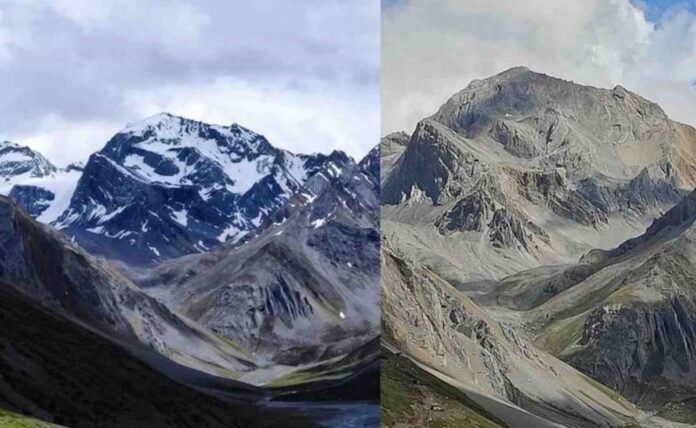
For the first time in recorded history, the iconic Om Parvat in Uttarakhand, known for its snow-clad peak that forms a natural “Om” symbol, stood bare and snowless last week, leaving locals and visitors alike in shock. Experts have attributed this unprecedented event to a combination of scanty rain, scattered snowfall in the upper Himalayan region, increased vehicular pollution, and the broader impact of global warming.
Om Parvat, situated at an altitude of around 14,000 feet in the Vyas Valley, is a revered site for both tourists and pilgrims, particularly those undertaking the Adi Kailash Yatra. The mountain’s snow-capped peak, which naturally forms a pattern resembling the sacred Hindu symbol “Om,” has long been a draw for visitors from around the world. However, on August 16, visitors were met with a stark and unrecognizable landscape, devoid of its signature snow.
“It was really disappointing to see Om Parvat, which has a reputation of being eternally clad in snow, utterly devoid of it,” lamented a visitor. Urmila Sanwal, a resident of the nearby Gunji village, echoed this sentiment, showing photos of the barren peak and noting how unrecognizable the site was without its usual snow cover.
Dhan Singh Bisht, who oversees the base camp for the Adi Kailash Yatra in Dharchula, expressed his dismay at the sight. “It is for the first time in my 22 years of service in Kumaon Mandal Vikas Nigam that I saw a completely snowless Om Parvat,” he said. Bisht explained that while the annual snow melting rate at Om Parvat typically ranged between 95-99 percent, this year, for the first time, it melted entirely.
The phenomenon has raised concerns about the future of tourism in the region. “Tourism could be impacted if the hill remained snowless for a longer period,” an official warned. The sudden disappearance of snow, which has always been a defining feature of Om Parvat, could discourage visitors and affect the local economy that heavily relies on tourism.
However, there was a glimmer of hope as snowfall on Monday night brought back some of the lost snow to Om Parvat. Bisht reported that the snow had returned, offering some relief to locals and officials who had been alarmed by the viral images of a snowless peak.
Sunil Nautiyal, Director of the GB Pant National Institute of Himalayan Environment in Almora, provided insight into the underlying causes of this alarming event. He pointed to rising temperatures in the eco-sensitive zones of the Himalayan region, driven by an increase in fuel-driven vehicles and the global phenomenon of warming. “To check this, we will have to determine the bearing capacity of all sensitive places in the high Himalayan region as well as rampant forest fires, as carbon generated by forest fires is also damaging the sensitive spots in the Himalayan region,” Nautiyal explained.
Another factor contributing to the disappearance of snow from Om Parvat is the significant rise in tourist footfall following Prime Minister Narendra Modi’s visit to Jolingkong in October last year. “Tourist footfall has gone up 10 times since Modi’s visit to Jolingkong for a darshan of the Adi Kailash peak,” said Krishna Garbiyal, a resident of Garbiyang village in Vyas Valley.
The situation at Om Parvat serves as a stark reminder of the delicate balance in our natural environment and the far-reaching impacts of human activity. As experts and officials work to understand and mitigate the factors leading to such dramatic changes, the need for sustainable tourism practices and stricter environmental regulations becomes ever more urgent.

